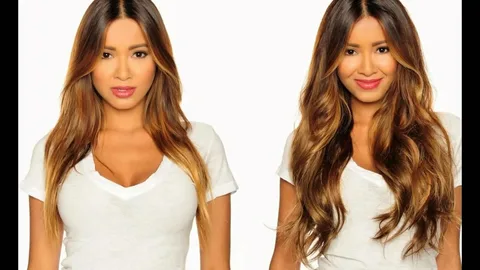Introduction:
Choosing the right hair extensions is more than just picking a style or length—it’s about achieving a seamless, natural look that enhances your beauty without revealing your secret. The biggest mistake people make when buying hair extensions is not paying enough attention to color matching. In this comprehensive guide, we’ll walk you through everything you need to know about how to match hair extensions with your natural hair color—from undertones and lighting tips to expert color-matching methods. Whether you’re a beginner or looking to refine your skills, this article is your go-to resource for flawless blending.
Why Color Matching Matters for Hair Extensions
When extensions don’t match your natural hair color, they stand out—and not in a good way. A mismatched extension can ruin your whole look, no matter how high-quality the hair is. Matching hair extensions with your natural hair color ensures a seamless, undetectable blend that boosts confidence and delivers professional-level results.
Key benefits of proper color matching:
- Seamless, natural appearance
- More styling versatility
- Better investment (you’ll actually wear them!)
- No need for costly salon color corrections
Understand Your Hair’s Undertones
Before you even look at extension swatches, it’s essential to understand your hair’s undertone. Hair undertones are the subtle hues underneath your primary color that can be warm, cool, or neutral.
Here’s how to determine your undertone:
| Natural Hair Shade | Likely Undertone | Matches With Extension Tones |
| Ash blonde/light brown | Cool (gray or blue) | Platinum, ash, cool beige |
| Golden blonde/brown | Warm (red or gold) | Honey, caramel, golden brown |
| Neutral black or brown | Neutral | Neutral shades or slightly warm |
Pro Tip: Take a photo of your hair in natural daylight—this gives you the most accurate view of your real color tone.
Match in Natural Lighting
The lighting in your home or salon can dramatically affect how a hair color looks. Fluorescent lights can make cool tones appear overly ashy, while warm lights can distort blonde shades into looking orange.
Always check your extensions in natural daylight—either by a window or outside—to ensure a true color match.
Choose the Right Extension Type Based on Your Hair Color
Different hair extension types absorb and reflect color differently. For example, synthetic hair doesn’t dye well and may appear shiny or fake if the color doesn’t match perfectly. On the other hand, Remy human hair extensions come in a variety of shades and can be dyed if necessary.
Top Tips for Picking Extension Types:
- If your hair is multi-tonal or highlighted, choose extensions with balayage or ombré shades.
- For solid hair colors, go for a single-shade match to avoid contrast.
- Use clip-ins or halos first to test before committing to permanent extensions.
Don’t Rely on Names—Use Swatches or Samples
Hair extension names like “Chestnut” or “Chocolate Brown” vary widely by brand. Always compare real swatches or order samples before buying. Many reputable brands offer color sample rings or small strands you can try at home.
Here’s how to test the match:
- Place the swatch against the mid-shaft to ends of your hair (not roots).
- Look at it under daylight and indoor lighting.
- Ask a friend or stylist for a second opinion.
Consider Getting a Custom Blend
If you’re struggling to find the perfect shade, a professional colorist can custom dye your extensions or your natural hair for a flawless match. Custom blending ensures you don’t have stark differences in tone or warmth, especially for complex color jobs like balayage, red tones, or silver-blonde hues.
Alternatively, choose from high-quality, fargeekte hårforlengelser (real hair extensions) that offer naturally blended tones and customizable options. With fargeekte hårforlengelser, blending becomes effortless and natural-looking—without damaging your existing hair.
Also read this: How to Choose a Statement Bag that Complements Every Outfit
How to Blend Extensions with Multi-Tonal or Highlighted Hair
If you have highlights, lowlights, or balayage, you’ll need to choose a set of extensions that incorporates multiple shades.
Look for:
- Multi-dimensional shades with subtle variations
- Rooted extensions for ombré or shadow roots
- Custom-toned extensions if your highlights are unique
Use a mix-and-match method—combining two extension shades close to your natural color—to recreate that multi-tonal effect.
Use Tools to Enhance Color Matching
Modern technology makes it easier than ever to match hair extensions without trial and error.
Try these tools:
- AI color-matching apps offered by many extension brands
- Color match quizzes on trusted websites
- Virtual try-on features using augmented reality
These tools don’t replace human judgment, but they’re a great starting point.
Common Mistakes to Avoid
Matching hair extensions with your natural hair color might sound simple, but even small mistakes can make a big difference.
Avoid these pitfalls:
- Choosing a match based on root color (always match from mid-shaft to ends)
- Ignoring undertones (ash vs. gold matters!)
- Buying synthetic extensions expecting a custom tone
- Using filters or tinted lighting when comparing shades
Final Tips: Maintenance and Color Longevity
Once you’ve matched your hair extensions perfectly, the next step is maintaining that match.
Follow these maintenance tips:
- Wash extensions with color-safe, sulfate-free shampoo
- Avoid heat styling too often—it can affect color integrity
- Store them properly to prevent fading or damage
- If your natural hair fades over time, refresh color with a gloss or toner.
Quick Checklist for Matching Hair Extensions
Here’s a simple checklist you can refer to:
✔ Determine your hair’s undertone
✔ Use natural daylight for color matching
✔ Compare extensions to mid-shaft and ends
✔ Choose multi-tonal extensions for highlights
✔ Try a sample or swatch before buying
✔ Use AI tools or quizzes for extra guidance
✔ Consider custom dyeing if needed
✔ Maintain with color-safe products
Explore more: Y2K Sweater: A Stylish Comeback from the Early 2000s
Conclusion: Match Like a Pro and Shine with Confidence
Getting the perfect match for hair extensions with your natural hair color isn’t just about aesthetics—it’s about feeling confident and beautiful. From understanding undertones to testing swatches in natural light and using smart tools, this guide has equipped you with everything you need to make an informed decision.
When in doubt, always invest in high-quality, real hair extensions that allow room for customization. Brands that offer fargeekte hårforlengelser make the process easier by providing rich, multi-dimensional shades that adapt to your unique color blend.
With the right match, no one will know you’re wearing extensions—and you’ll look and feel amazing.


